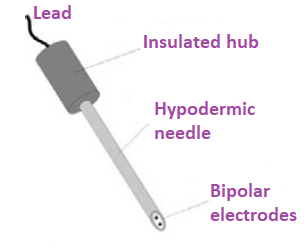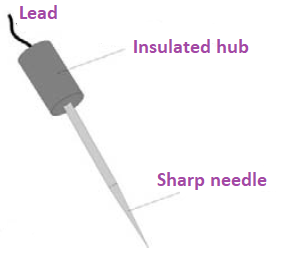We have different types of biopotential electrodes that are used in recording electromyographic (EMG) signals from different muscles in the body.
The shape and size of the recorded EMG signals depend on the electrical property of these electrodes and the recording location. For non-invasive recordings, proper skin preparation, which normally involves cleansing the skin with alcohol or the application of a small amount of an electrolyte paste, helps to minimize the impedance of the skin-electrode interface and improve the quality of the recorded signal considerably. The most common electrodes used for surface EMG recording and nerve conduction studies are circular discs, about 1 cm in diameter that are made of silver or platinum.
Related: ECG Electrodes
For the direct recording of electrical signals from nerves and muscle fibres, a variety of percutaneous needle electrodes are available as demonstrated in the figures below:


The most common type of needle electrode is the concentric bipolar electrode illustrated in figure (a) above. This electrode is made from thin metallic wires encased inside a larger canula or hypodermic needle. The two wires serve as the recording and reference electrodes. Another type of percutaneous EMG electrode is the unipolar needle electrode that is shown in figure (b) above. This electrode is made of a thin wire that is mostly insulated by a thin layer of Teflon, except about 300 μm near the distal tip. Unlike a bipolar electrode, this electrode requires a second unipolar reference electrode to form a closed electrical circuit. The second recording electrode is normally placed either adjacent to the recording electrode or attached to the surface of skin.
You can also read: Types of Bioelectrodes
Find out more about: Fingertip Pulse Oximeter Blood Oxygen Saturation Monitor

Leave a Reply
You must be logged in to post a comment.